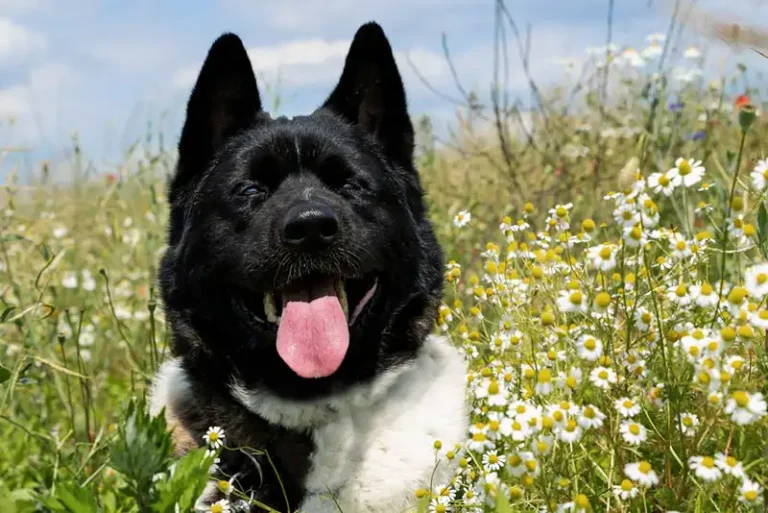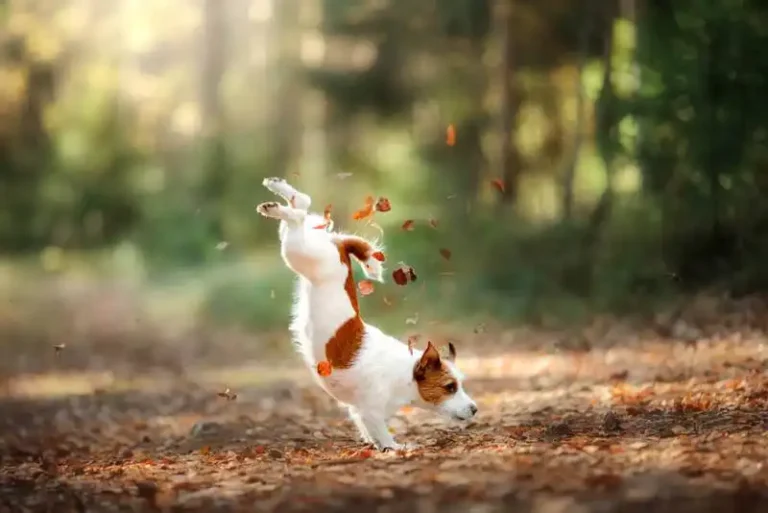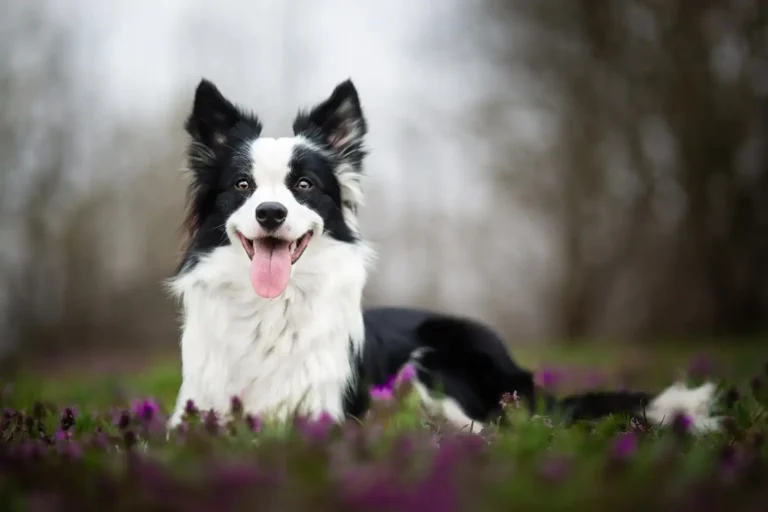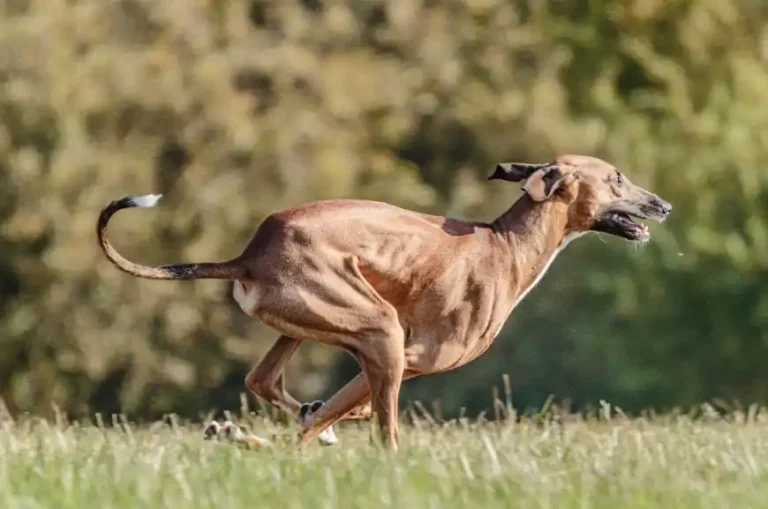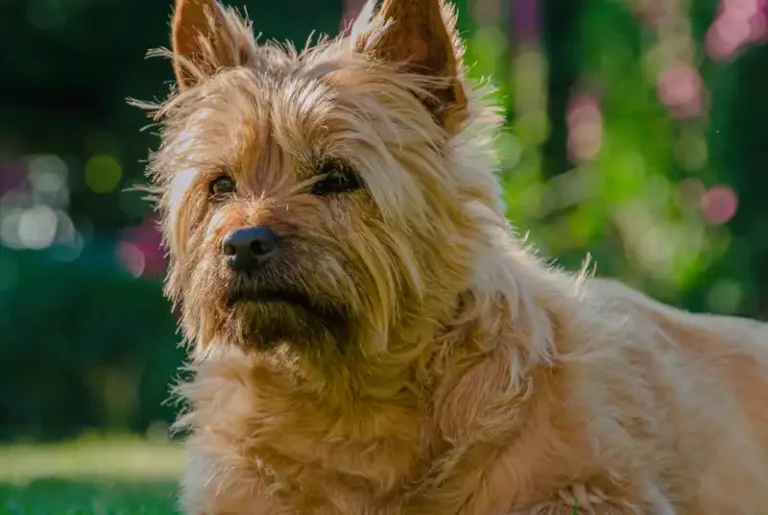Australian Cattle Dog-Australian Heeler
Australian Cattle Dog (also Australian Heeler, Blue Heeler, Australian Cattle Dog, Australian Bouvier).
Country of Origin: Australia
Size: medium
Height: 43-51 cm
Weight: 13-28 kg
Age: 12-16 years
FCI breed group: Sheepdogs and Cattle Dogs, except Swiss Cattle Dogs
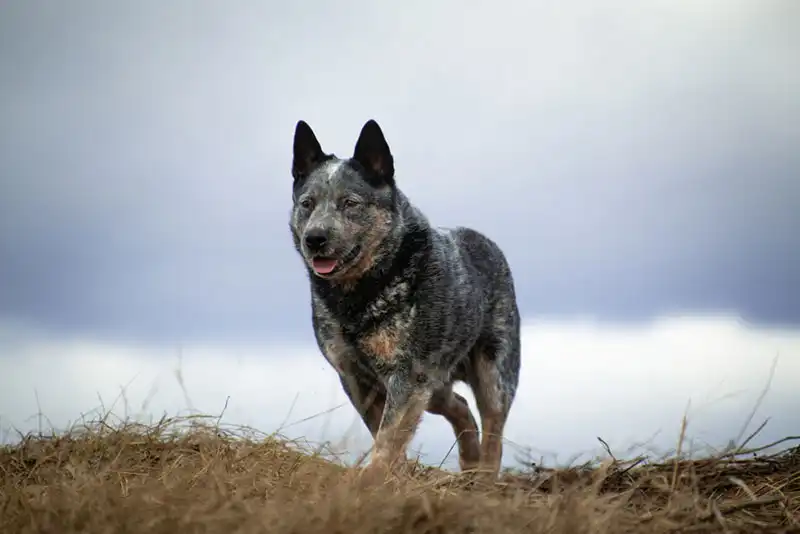
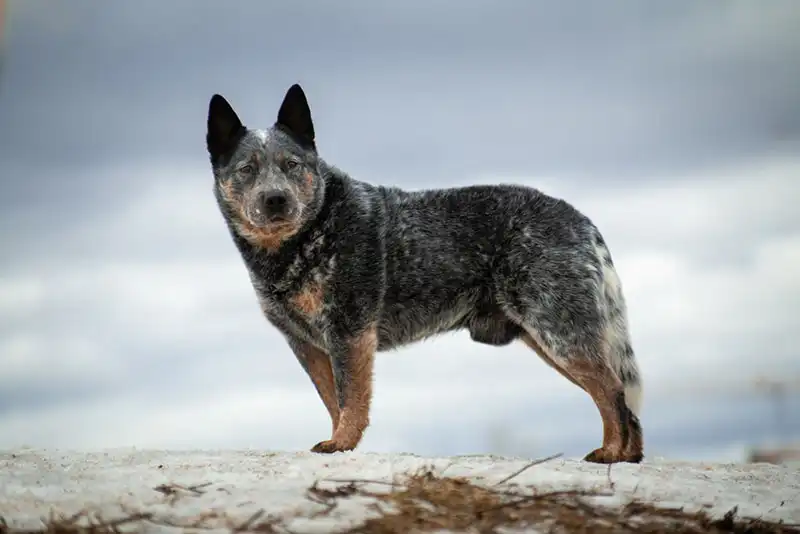
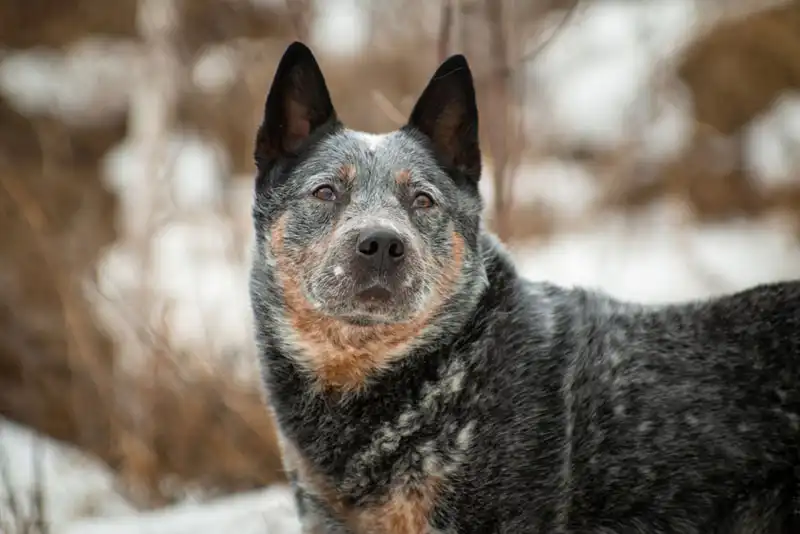
Basic information
The Australian Cattle Dog is a powerful athlete, in whose veins the genes of a wild predator and several breeds from the Old World, shepherds and others, are interestingly mixed.
- One of its ancestors is the dingo dog. From it, the heeler has adopted many of its qualities, which it does not lose even when becoming a city dweller.
- A real hard worker, he must be busy; if the dog is not a service dog, but a pet, then he needs sports, a lot of exercise.
- They are very sensitive dogs, they should never be scolded, raised, punished, or treated rudely, it is enough to let them know what exactly you want, and your four-legged friend will try to please them and will be happy when it works.
- Strong and resilient, passionate, loves challenges and excels at them, the Australian Heeler is a working dog to the core.
Historical background
Heelers were developed in Australia in the 19th century. The dogs that settlers brought with them were not suitable for driving cattle herds across rough terrain, among bushes and rocks. But there was no other choice – before the invention of refrigeration, this was how cattle had to be transported.
The drivers needed help, and for a while the Smithfield dogs became their assistant – large, collie -like dogs , but they barked a lot and scared the ungulates.
Thomas Simpson Hall, a farmer and son of a British colonist, mixed Smithfields with dingoes, wanting to consolidate the necessary qualities. The result of long work was used for some time in herding, but the animals had a serious drawback – they needed constant supervision of a shepherd. Then bull terriers were added to the dingo blood , and later – blue collies. Their offspring were called Hall’s Heelers, the dogs turned out excellent. Thomas Hall did not give away the puppies, so as not to lose the advantage among farmers.
After Thomas’s death and the sale of his farm, the dogs came to the attention of the Bagust family, who improved their characteristics by crossing them with Dalmatians and Kelpies . This is how the Blue Heeler, the ancestor of the modern Australian Cattle Dog, was born.
One of the Bagusts’ associates, Robert Kaleski, made a great contribution to the development of the breed. He actively promoted the dogs as working dogs, and in 1903 he compiled the very first standard, which has changed little to this day.
In the mid-20th century, the breed split into different branches: the Australian Cattle Dog and the bobtail Stumpy. The latter retained their original features, but the Australian Heeler became more massive. But the most obvious difference is the length of the tail.
Nowadays the breed is quite well known and is bred by clubs and nurseries all over the world.
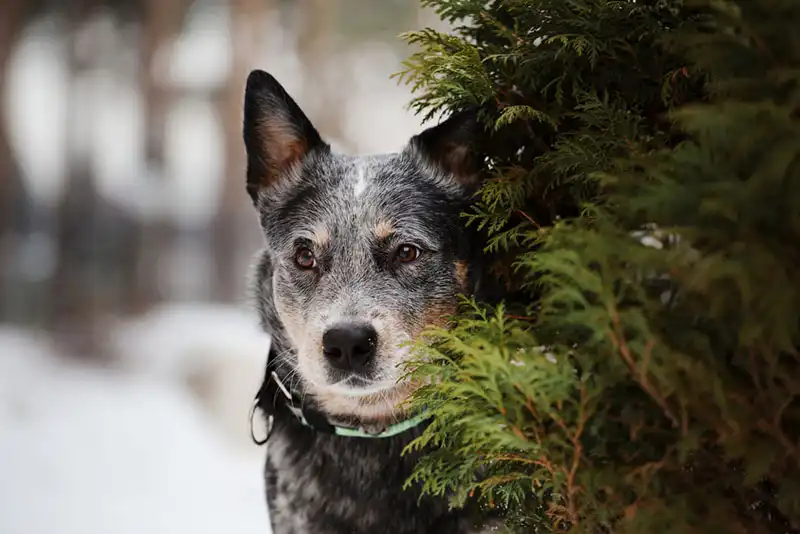
Description of the Australian Cattle Dog
The Australian Heeler is an athletic dog with a dense, stocky figure and an unusual coloring, which has retained many features of its wild ancestor. At first glance, it gives the impression of enormous strength. The dogs have an athletic build, their muscles are well developed, which provides them with maneuverability and speed. The coat is smooth, tight-fitting, there is an undercoat.
Head
Wide, slightly rounded between the ears. The transition to the muzzle is well defined.
The muzzle is wide, powerful, not long, slightly narrowing towards the nose. The lips are strong and dry. The jaws, especially the lower jaw, are excellently developed. Scissor bite , healthy white teeth. The dental formula should be complete. The nose is evenly colored black, without spots.
Eyes
Medium in size, oval in shape. Not bulging or sunken. Intelligent look. Eyes have a wary expression if a stranger approaches. Color brown, very dark is preferable.
Ears
Not particularly large, wide at the base, triangular, slightly pointed, without roundness. Set wide apart and facing out to the sides. Standing upright. Thick, covered with hair inside.
Neck
Strong, muscular and firm, slightly widening towards the body. The skin on the neck should not hang or form folds. There is no collar, or it is practically invisible.
Frame
Powerful, solid, back and loin are wide. The muscular frame is well developed, the chest is of medium width. The croup is slightly sloping, the topline is straight, without deflections, the groin is deep.
Tail
Low set, continues the line of the back, medium length. When calm, it is lowered and slightly curved, when excited, it rises, but does not stand upright and certainly does not bend towards the back. It has a thick and dense “brush” of fur.
Limbs
Strong, with pronounced but not overloaded muscles, straight, set at medium width. Strong hocks with a good angle. Metacarpus, when viewed from the side, is slightly inclined, this provides the dog with greater smoothness of movement. Paws are rounded, toes are not long, with a high arch, tightly gathered. Thick hard pads, claws are strong, small.
Movements
Free and smooth, the front part of the body moves synchronously with the back, which gives a powerful push of the paws. The ability to move very quickly is mandatory. When the dog runs, the paws are slightly closer to the central axis of the body, in a stance they are located at the corners of a rectangle.
Wool cover
Smooth fur with short and thick undercoat fits tightly to the body and protects well from water. It is slightly longer towards the back of the body, on the paws and head, including the ears, it is short. On the neck, the fur is longer and denser, but it does not form a distinct collar. The average hair length is 2.5-4 cm.
Australian Heeler Coloring
There are two color options. The first, for which the breed got its name, is blue-speckled. The main color of the animal is blue, blue, blue with speckles. There may be black, blue or yellow-red spots that create a “mask” on the muzzle, it is better if they are symmetrical. There may be tan on the front legs, chest and neck, and on the cheekbones too. On the hind legs, the tan goes down the inside of the thigh to the tips of the fingers. Light undercoat is allowed only if it is not visible through the coat. It is better if there are no black spots on the body.
The second option is red-speckled. Light undercoat is not allowed, the color should be saturated all over the body, a “mask” on the head is welcome.
Brown and light colours are classified as unacceptable.
An interesting feature is that healers of all colors are born white, minus very dark markings. At about 4 weeks, black or red hairs begin to grow through the puppy’s white fur, unevenly colored, without any clear pattern, densely mixed with white. This effect is called ticking coloring. If we talk about the “wild” coloring of cats, then this is also an example of ticking, only in the Australian Heeler it is more chaotic.
Many dogs have a light tip of the tail and a dark spot at its base, as well as a white “star” on the head.
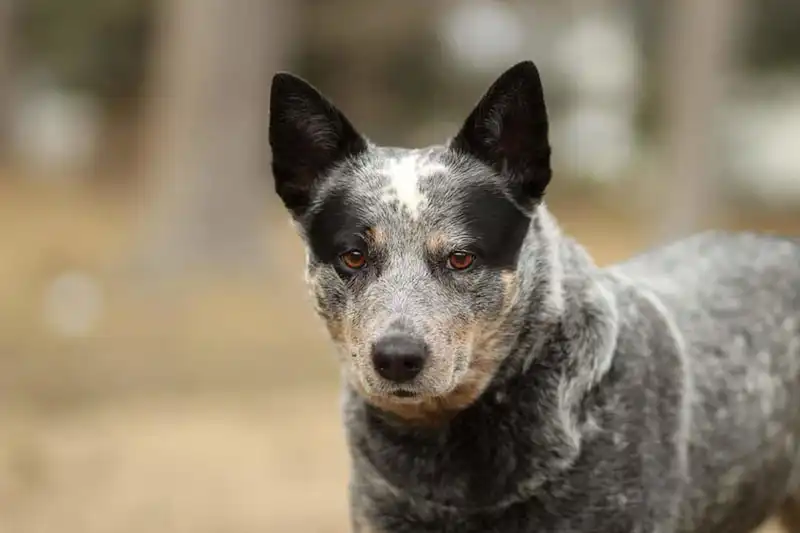
Size and weight
The dog is not tall, the height at the withers ranges from 43-51 cm. Weight – from 13 to 28 kg.
Australian Cattle Dog Personality
Smart, freedom-loving, curious, fantastically energetic animals with a gentle and sensitive mental organization. Excellent guards, extremely distrustful of strangers, with other dogs the dog adheres to a strict hierarchy.
The Australian Heeler is quite stubborn and willful, so he needs an owner who knows how to demonstrate his authority.
The dog will get along well with older children, but the younger ones who run and shout will irritate him with their behavior. He will try to start “educating” them and will try to herd them together like a herd. It should be understood that this is not aggression, but a manifestation of the working qualities of the breed, long and consciously cultivated in the process of breeding.
This is how the Australian Shepherd works with the herd – drives, directing in the right direction. Therefore, families with children under 4 years old are not advised to get an Australian Heeler, it is best to do this when the child grows up and can work with the dog himself.
Heelers especially need early socialization.
Despite the love of freedom, the dog becomes the kindest and most devoted friend. But in no case should you treat him rudely, sensitive and independent, the pet will react to this with resentment. If you do not control and educate him during his growing up, then in the future it will be difficult to cope with unwanted behavior.
Throughout its existence, the Australian Shepherd has firmly occupied the top lines of the ranking of the smartest and most active breeds. Inexperienced and unsure owners should not get it, the pet will very soon sense the owner’s weakness and take the reins into its paws.
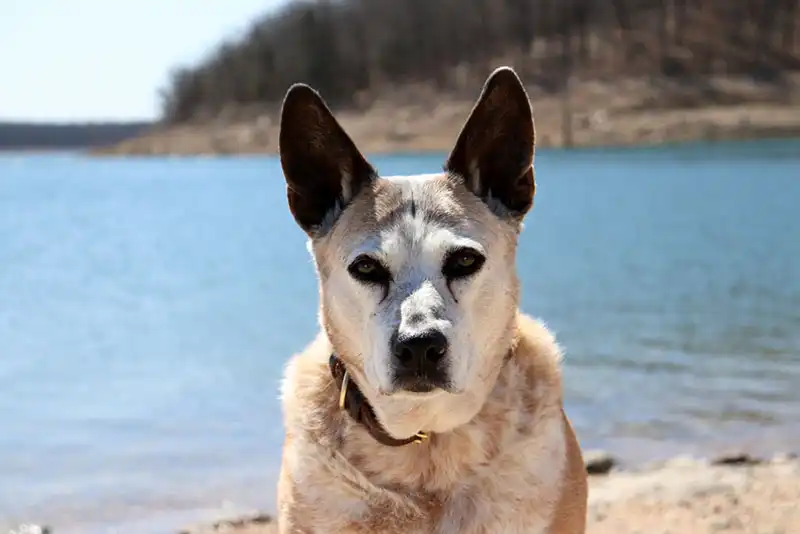
Dog education and training
Dogs are distinguished by their intelligence and quick wits. The Australian Cattle Dog is simply created for training. Moreover, training simple commands is suitable only for small puppies at the initial stage, they will master simple well-known commands and want to move on. This breed requires daily, structured, diverse training, the Heeler requires complex tasks, where its resourcefulness, physical strength and intelligence will come in handy.
Extremely active, strong, a true athlete, the Blue Heeler is capable of exhausting even an athlete, his owner must be as resilient as his dog.
Training is the most important condition for maintaining the breed. Without training, the dog will become willful, restless, and disobedient. The reason for this is not character defects or genetics, the healer will get bored with nothing to do and will start to have fun on its own.
Before bringing the baby into the house, remove all things from accessible places, check the furniture doors, prepare diapers, a bed, bowls and toys.
Education begins from birth. By the time the baby is taken away from its mother, it must firmly understand that communication with a person brings benefit and pleasure and strive for it. This is, of course, the breeder’s task, to communicate with their charges, to teach them to react to people, to play, to caress. Training should be carried out in a playful manner, without shouting and rudeness.
The next stage is socialization , which should be started as early as possible. The dog learns the rules of behavior in communication with the owner, his family and other people. It is especially important to teach the dog to guard and obey younger family members, and children to treat the animal correctly. Approach this issue responsibly, do not leave the dog and child playing unattended, and there will be no problems.
There are important rules in raising this breed. Dogs should not be scolded or harshly pulled up. The puppy should be praised as much as possible, if it does something wrong, calmly explain to it what you want. The absence of praise is quite a sufficient measure, babies are very observant and quickly understand everything from a person’s reaction.
At first, the little pet will try to bite your legs. This is a natural manifestation of working qualities. Do not punish them for them, to stop such behavior, firmly say “no”, “you can’t” and move the puppy away a little. This is exactly what their mothers do when raising their offspring, at first it is useful to imitate these techniques, then it will be enough to just say “no”.
As soon as your four-legged friend grows up a little and learns the basics of training , the most interesting part begins. Agility, canicross, skijoring, bikejoring, flyball, Schutshund– this is only part of the disciplines where the Australian Cattle Dog will show itself in all its glory. Structured training, development of intelligence, obstacle course – this is the key to interest and success. With proper training, representatives of this breed can be assistance dogs for people with disabilities (guide dogs, for example), as well as bloodhounds, police dogs, rescuers.
Maintenance and care of the breed
No special products are required to care for this dog, it is enough to follow general recommendations. Extremely unpretentious, Australian shepherd dogs adapt to any conditions, but they also need hygiene procedures.
Brush your pet’s teeth , this can be done with coarse food (for example, vegetables, provided that a natural diet is used) special dental treats. Brushing with veterinary pastes can be done daily.
Claws are trimmed as needed. The pet’s ears usually need to be cleaned once every two weeks. If inflammation is detected in the auricle, it is important to contact the clinic.
The fur is combed daily during shedding, in other periods it is enough to do it a couple of times a week. Before the show, the dog is wiped with a damp cloth or napkin to bring it into proper condition. If the animal is dirty, it is washed, this is done with veterinary shampoo in warm water.
As for the conditions of keeping, the best option here would be a private house. Heelers require a lot of space for games and activities, so an apartment will be cramped for them. If you still get this breed in a city dwelling, walk and play as much and often as possible, without physical activity the dog will get bored.
The pet will not need clothes in winter, unless you live in a very cold northern region; the heeler adapts perfectly to the Siberian climate. Shoes are required in rare cases, for example, in case of injuries, or if the dog needs to walk in a dangerous area where there are sharp shards of glass and the like. Service dogs, especially those working in difficult situations, are always given shoes. In severe frost, it is also better to protect the paws.
How and what to feed your pet?
Australian Heelers are not only undemanding to the conditions of keeping, but also to food. Long cattle drives across difficult terrain were not suitable for the sissies, and good digestion was a necessary feature for this breed.
You can choose a ready-made diet for your pet or feed it natural products; either option will suit it.
Natural feeding is more complicated. Maintain the correct balance of proteins, fats and carbohydrates. A dog is a predator. An adult animal needs at least 23-25 grams of protein per kilogram of weight per day, and its content in meat ranges from 18 to 25%.
In addition, be sure to add a vitamin and mineral complex, modern food products cannot provide the necessary dosage of nutrients. Vitamins should be selected together with a veterinarian. It will not be possible to obtain nutrients from vegetables in the required amount, predators do not digest them well, and most of them will come out in their original form. However, they are essential in a home diet, some will still be digested, and fiber will improve the functioning of the stomach.
Feeding with prepared rations is much easier.
The most important thing is to choose a quality product and correctly calculate the amount of food, for a healer, as a rule, it will be higher than for most breeds. Increased activity requires a lot of energy.
It is better to entrust the calculation of the daily portion to a specialist – a veterinarian or nutritionist. Vitamins and minerals are already included in the complete feed, and you will not have to cook. Focus on trusted manufacturers.
Feed dogs after a walk. If you eat before a walk, it can lead to gastric torsion.
Water should always be available in any quantity, it should not be limited. Do not feed from your table, you should not encourage such behavior, besides, some human food can be dangerous for animals.
Products that should never be given:
- Chocolate;
- Salt and spices;
- Smoked and fatty;
- Any citrus fruits;
- Grape;
- Tubular bones;
- Raw meat and fish;
- Avocado;
- Sweets ;
- Onion and garlic.
Follow these simple recommendations, and your pet will not have any health problems.
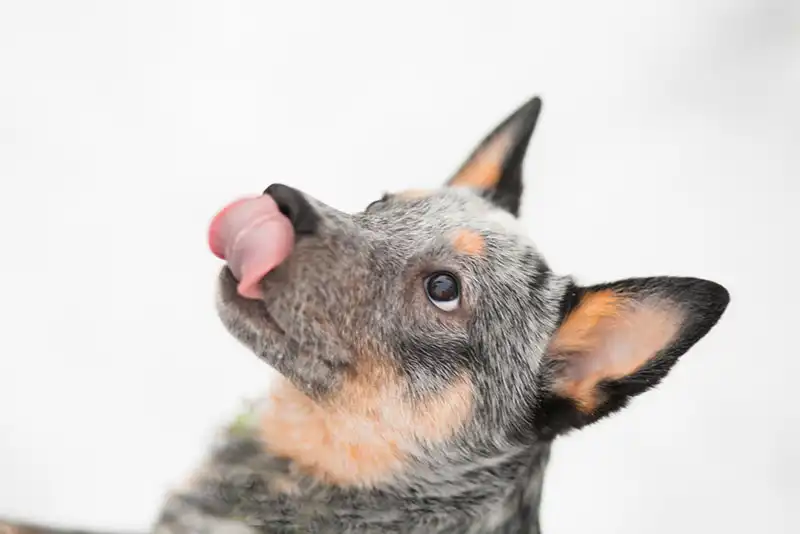
Health
The main problem for the Australian Cattle Dog is not diseases caused by heredity, infection or other factors, most likely you will not encounter them. The main scourge of healers is injuries. Fractures, dislocations, bruises, sprains, cruciate ligament ruptures and the like are a direct consequence of the hyperactive lifestyle and high loads required by these tireless athletes.
Of course, there is also a tendency to some diseases. One of the genetic deviations is eye pathologies, namely progressive retinal atrophy. It is inherited, if the parents were carriers, then the puppies will most likely sooner or later also get sick. Since the advent of DNA tests, such dogs have ceased to be allowed to breed, but sometimes the disease still occurs.
Australian Heelers are also prone to congenital deafness, a common affliction in all breeds with a variegated coat. They can be deaf in one ear or both, partial deafness will not be considered a disadvantage for shows and will not affect your communication with your pet, but you cannot have puppies from such animals. At the age of 6 weeks, club babies are given a BAER test to identify pathology.
In USA, such tests are just beginning to be introduced, but serious nurseries carry them out. When buying a puppy, you can clarify this point with the breeder or try to determine it yourself. According to Australian researchers, dogs that do not have dark spots on the muzzle or body most often suffer from deafness.
Other health problems also occur periodically, among them spondylosis is the most common – degeneration of the spine, the result of high loads. Less common are problems with the reproductive system – pyometra (infection of the uterus), infertility and false pregnancy.
Always follow the general rules: visit the vet on time, do not miss vaccinations, treat for external and internal parasites. These simple measures will protect your dog from the vast majority of problems, and it will please you with excellent health for a long time.
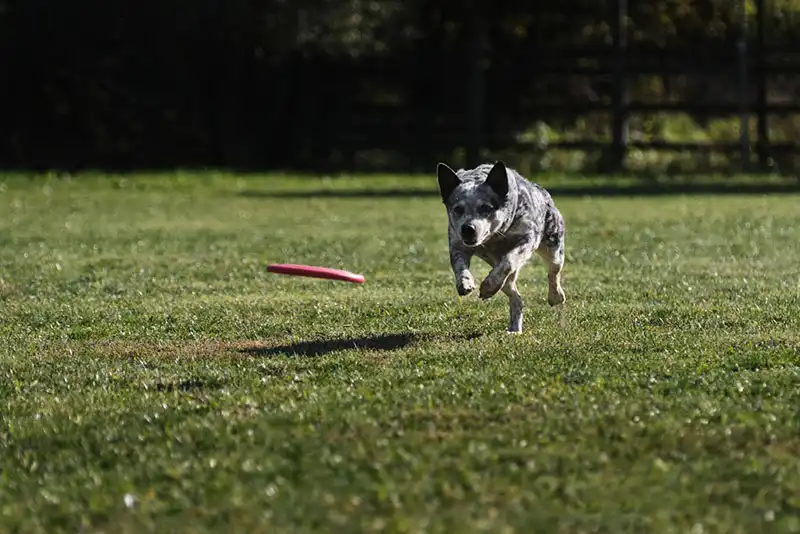
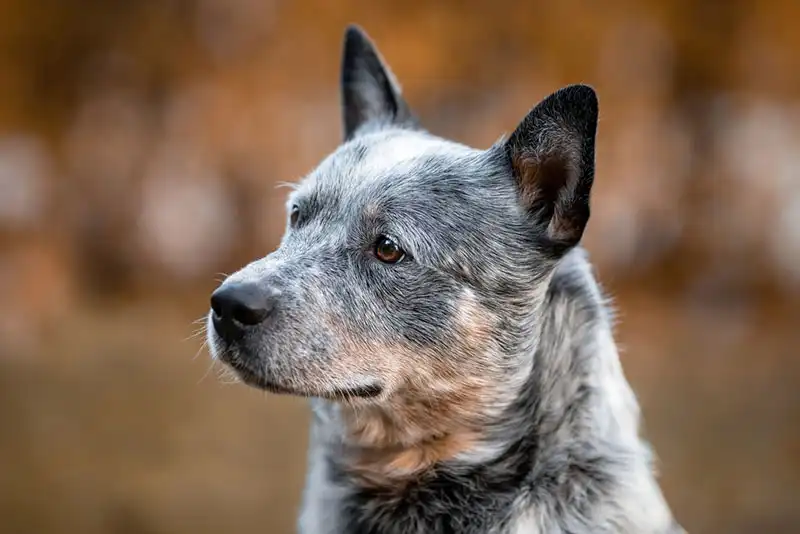
Who is this breed suitable for?
- Who will find the Australian Shepherd Dog a great friend and companion:
- For dog handlers;
- For amateur dog breeders with extensive experience;
- For athletes interested in dog disciplines;
- For active people who are ready to work with a pet under the supervision of a specialist;
- For rural residents, shepherds;
- To police officers, customs officers, rescuers and other services;
- Families with sufficiently grown children;
- For those who are ready to be a leader in their relationship with their pet.
- It’s better not to get a dog like this:
- If there is no physical training;
- For families with small children;
- For pensioners;
- People with poor health;
- For those who cannot devote much time to their pet;
- For homebodies who lead a measured lifestyle.
When buying a dog, calculate your strength correctly, all animals require attention, but some need it more. Therefore, choosing the right breed is a very responsible matter. If you have any doubts, consult with experts.
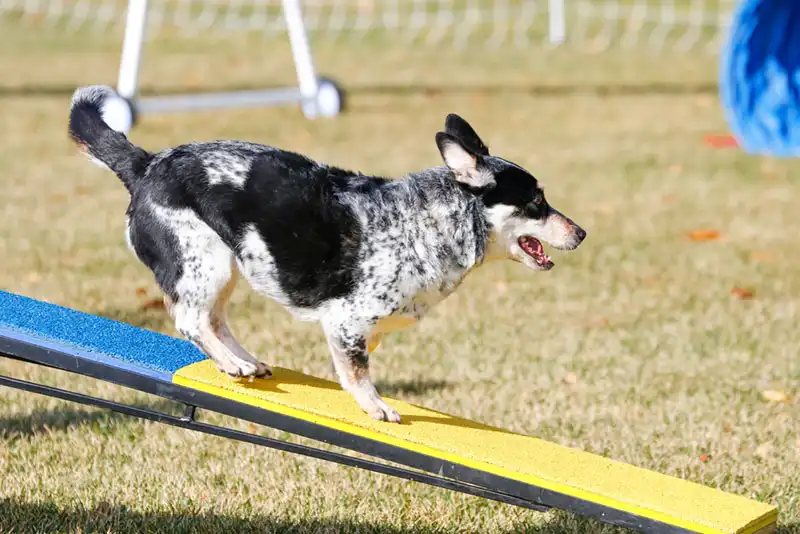
Tips for choosing a puppy
There are several kennels in Russia that breed Australian Heelers, but you will most likely have to sign up in advance and wait patiently, because there are very few litters. Sometimes puppies are available for sale, if you find such babies, do not miss the moment. Having decided to get this breed, find a breeder with good reviews and contact him.
It is best to visit the kennel yourself and look at the dogs and the conditions in which they are kept, but if this is not possible, check its reputation, for example, by consulting with clubs or on the RKF website. There you will find information about the sellers and understand where it is better to go.
Do not rush to respond to private ads, there are many people who breed dogs without control, not caring about the quality of the offspring, or the reputation of the breed. Having decided on such a step, be sure to check the pedigrees and veterinary passports of the parents, so you will get an additional guarantee that the puppy will be healthy and purebred.
Examine the baby when you pick it up, it should be well-groomed and active. The skin of a healthy dog is clean, without diaper rash or rashes, the fur is shiny, the nose does not run, there is no discharge from the eyes, they are clear, mucous pink, in no case whitish, the ears are clean, not reddened, the belly is not swollen.
If the baby ran away and hid when he saw you, he may have a weak nervous system. For an Australian Shepherd, this is a serious drawback; it will be more difficult to socialize and train such a puppy.
Personal experience of the owners of these dogs
Without exception, all owners note the bubbling energy of their four-legged friends.
- In addition, they highlight the following characteristics of pets:
- Puppies show no signs of stress when they are brought into a new family, and immediately behave as if they have always lived there;
- In their excitement, they may not notice a tree or other obstacle and crash into it;
- Minor injuries are common;
- Impressive and noticeable, they attract attention;
- They are very affectionate with their family, love to hug, and do not keep their distance;
- In the heat they climb into the water, they will jump into puddles, but almost all the dirt is shaken off from the fur along the way; at home it is enough to wipe it with a rag;
- Apart from injuries, there are no health problems;
- They try to be as close to the owner as possible, and very carefully observe the person’s reaction;
They require an owner who can be a leader; - They need proper training, otherwise they will be disobedient;
- React to commands with lightning speed;
- They are able to independently and competently control their condition, they will not run in the sun in the heat, they will not mindlessly run in circles, they will devote more time and attention to research, even during play, if necessary, they will turn on the “energy saving mode”;
- Ideal for hiking, tourism;
- They closely monitor any suspicious object and have a well-developed guard instinct;
- If they bark, it means they want something or are giving a signal.

